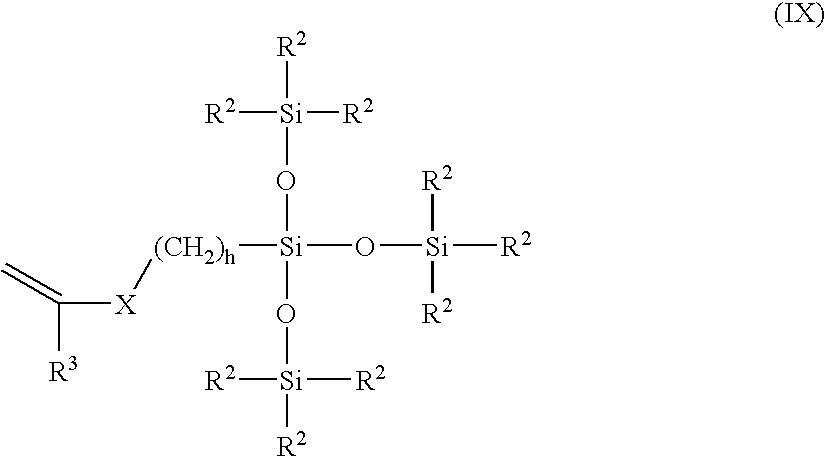Rigid gas permeable lens material
a technology of rigid gas and lens material, which is applied in the field of copolymers, can solve the problems of compromising other desired properties of the material, machineability or optical clarity, and the inability of the lens to be safe for overnight wear,
- Summary
- Abstract
- Description
- Claims
- Application Information
AI Technical Summary
Benefits of technology
Problems solved by technology
Method used
Image
Examples
example 1
Preparation of α,ω-bis(4-hydroxybutyl)polydimethylsiloxane (Mn about 4000)
[0083]A 2-L, three-neck round bottom flask equipped with one reflux condenser, was charged with the following: 50.8 grams (0.182 moles) of 1,3-bishydroxybutyl tetramethyldisiloxane; 985.6 grams (8.1 mole) of dimethoxydimethylsilane; 145.8 grams (8.1 mole) of distilled water; and 18.2 mL of concentratd hydrochloric acid. The mixture was heated at 60° C. for one hour. Methanol was then distilled off over a 5-hour period, with 650 mL collected. Six hundred and fifty mL of 6N hydrochloric acid was then added and the contents were refluxed for 4 hours. The crude product was then separated from the aqueous layer. Ether was added and the solution was extracted twice with 0.5 N sodium bicarbonate solution, and then with distilled water until the washing had neutral pH. The product was then added slowly into a mixture of methanol / water (77.5 / 22.5). The bottom organic layer was separated, ether was added, and dried with...
example 2
Preparation of α,ω-bis(4-hydroxybutyl)polydimethylsiloxane (Mn about 3600)
[0084]The general procedure of Example 1 was followed, except the molar ratio of 1,3-bishydroxybutyl tetramethyldisiloxane to dimethoxydimethylsilane was 1:39 instead of 1:45 as in Example 1. The Mn of the product as determined by titration was 3689.
example 3
Preparation of a polydimethylsiloxane-based polyurethane prepolymer, using α,ω-bis(4-hydroxybutyl)polydimethylsiloxane (Mn about 4000)
[0085]A dry 3-neck, 1000-mL round bottom flask was connected to a nitrogen inlet tube and a reflux condenser. Then, the following were added to the flask and the contents were refluxed: isophorone diisocyanate (16.916 g, 0.0761 mole); diethylene glycol (4.038 g, 0.0380 mole); dibutyl tin dilaurate (0.383 g); and 140 mL of methylene chloride. After 16 hours, the amount of isocyanate was determined by titration to decrease to 47.0%. Then α,ω-bis(4-hydroxybutyl)polydimethylsiloxane (102.56 g, 0.02536 mole) from Example 1 was added into the flask. The refluxing was continued for 33 hours, and the amount of isocyanate dropped to 14.1% of the original, as determined by titration. The contents were then cooled to ambient temperature. 2-Hydroxyethyl methacrylate (2.2928 g) and 1,1′-bi-2-phenol (0.0129 g) were then added, and the contents were stirred at ambie...
PUM
| Property | Measurement | Unit |
|---|---|---|
| Rockwell hardness | aaaaa | aaaaa |
| Rockwell hardness | aaaaa | aaaaa |
| Rockwell hardness | aaaaa | aaaaa |
Abstract
Description
Claims
Application Information
 Login to View More
Login to View More - R&D
- Intellectual Property
- Life Sciences
- Materials
- Tech Scout
- Unparalleled Data Quality
- Higher Quality Content
- 60% Fewer Hallucinations
Browse by: Latest US Patents, China's latest patents, Technical Efficacy Thesaurus, Application Domain, Technology Topic, Popular Technical Reports.
© 2025 PatSnap. All rights reserved.Legal|Privacy policy|Modern Slavery Act Transparency Statement|Sitemap|About US| Contact US: help@patsnap.com



